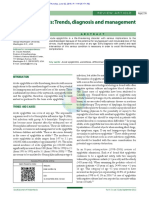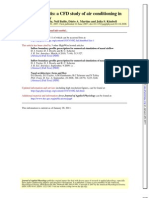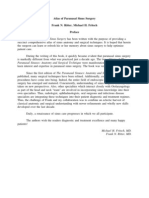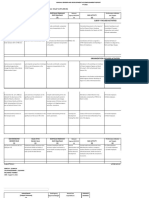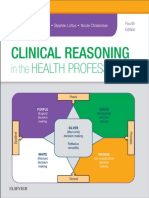Abses Septum
Abses Septum
Uploaded by
witariCopyright:
Available Formats
Abses Septum
Abses Septum
Uploaded by
witariOriginal Title
Copyright
Available Formats
Share this document
Did you find this document useful?
Is this content inappropriate?
Copyright:
Available Formats
Abses Septum
Abses Septum
Uploaded by
witariCopyright:
Available Formats
International Journal of Otolaryngology and Head & Neck Surgery, 2013, 2, 79-81
http://dx.doi.org/10.4236/ijohns.2013.23019 Published Online May 2013 (http://www.scirp.org/journal/ijohns)
Spontaneous Nasal Septal Abscess Presenting as Complete
Nasal Obstruction
Joseph Chun-Kit Chung*, Athena Ting-Ka Wong, Wai-Kuen Ho
Division of Otorhinolaryngology, Head & Neck Surgery, Department of Surgery, The University of Hong Kong,
Queen Mary Hospital, Hong Kong, China
Email: *jckchung@graduate.hku.hk
Received March 23, 2013; revised April 3, 2013; accepted May 3, 2013
Copyright 2013 Joseph Chun-kit Chung et al. This is an open access article distributed under the Creative Commons Attribution
License, which permits unrestricted use, distribution, and reproduction in any medium, provided the original work is properly cited.
ABSTRACT
Nasal septal abscess is an uncommon condition, yet presents as a rhinological emergency. Its symptoms resemble upper
respiratory tract infection and the diagnosis may be missed leading to intracranial complication and cosmetic deformity.
We present a healthy patient with idiopathic nasal septal abscess who complained of acute complete nasal obstruction,
fever and nasal pain. Common aetiologies, causative agents, complications and management of nasal septal abscess are
discussed.
Keywords: Nasal Septum; Abscess; Emergencies
1. Introduction
Nasal septal abscess is an uncommon condition. High
index of suspicion and prompt drainage is required to
prevent intracranial infection and future nasal deformity.
However the clinical manifestations may be subtle and
mimic upper respiratory tract infection. It usually happens after surgery or trauma. Here we present a case of
spontaneous nasal septal abscess and discuss the management plan.
2. Case Report
A 41-year-old gentleman who enjoyed good past health
was referred to our ENT clinic by his family physician
with four days history of complete nasal obstruction,
fever and nasal pain. He also had prior history of myalgia
and headache for 1 week. There was no prior history of
nasal surgery, trauma. On physical examination, his nasal
dorsum was swollen and tender. Anterior rhinoscopy
revealed bilateral cherry red septal bulge (Figure 1).
Other than running a fever of 38.8C, there was no associated neurological deficit or neck stiffness. The rest of
the examination including nasoendoscopy was unremarkable. The diagnosis of nasal septal abscess was confirmed by needle aspiration of pus. The sample was sent
for culture and sensitivity testing. His white blood cell
count was elevated to 2.1 1010/l with neutrophil pre*
Corresponding author.
Copyright 2013 SciRes.
dominance. Blood glucose was normal. Urgent CT scan
revealed a 3 cm 1.2 cm 1.6 cm ill-defined rim enchancing hypodense collection at the anterior nasal septum (Figures 2(a) and (b)). The rest of the paranasal
sinuses were clear. Dental assessment later could not
identify any infection of dental origin.
Emergency transnasal drainage of the abscess under
general anaesthesia was subsequently performed. Intraoperatively, the central portion of cartilaginous nasal septum was necrotic and destroyed by infection. The superior and caudal septal cartilage struts were still intact, but
soften and thinned as a result of inflammation (Figure 3).
A drain was anchored in the abscess cavity and both nasal cavities were packed with merocele.
Figure 1. Nasal septal abscess resembling hypertrophic turbinates.
IJOHNS
J. C.-K. CHUNG
80
ET AL.
Figure 3. Central cartilage destruction by inflammation,
superior and caudal strut (S) still preserved.
(a)
(b)
Figure 2. Computer tomographic scan: (a) Axial cut showing abscess involving anterior cartilaginous nasal septum;
(b) Coronal cut showing showing no intra-cranial extension.
Bacteriological culture yielded methicillin-sensitive
Staphylococcus aureus that was sensitive to Augmentin.
Patient was treated accordingly for 2 weeks. Follow up
nasoendoscopy at 2 weeks showed intact nasal septum
and complete resolution of the abscess. At 6 months later,
he noted a mild depression over his nasal dorsum. Augmentation rhinoplasty has been suggested, but he refused.
3. Discussion
Nasal septal abscess is a collection of pus between the
nasal septal cartilage or bony septum and the mucoperichondrium or mucoperostium [1]. This entity was first
Copyright 2013 SciRes.
reported in 1810 by Arnal who assisted Cloquet to drain
a nasal septal abscess in a patient suffering from coryza
[2]. The commonest aetiology is nasal trauma leading to
haematoma formation and subsequent infection [2,3].
Nearly 75% are secondary to nasal injury [1]; less frequently following septal surgery. Other causes include
localized nasal sinusitis, vestibulitis [3-5]; nearby dental
abscess, infected dentigerous cyst [6]; an immunocompromised state in patients who suffered from diabetes
mellitus, HIV infection or receiving chemotherapy [2,7].
In the literature, there are only two idiopathic nasal septal
abscesses reported previously [8], similar to the present
case. Most of the abscess cavity situated at the anterior
cartilaginous nasal septum. Posterior septal abscess may
be missed if only anterior rhinoscopy is performed [4].
The most common presenting symptom of nasal septal
abscess is nasal obstruction and pain [2], in distinction
with uncomplicated septal haematoma which usually
presents as painless nasal obstruction after injury. Other
symptoms include fever, malaise, headache and epistaxis.
On rhinoscopy, this uncommon pathology is often mistaken as inferior turbinate hypertrophy, deviated nasal
septum or simple mucosal oedema [2,4] by less experience physicians and causal examination. This may be
avoided by cautious inspection and palpation, confirming
a fluctuant swelling arises from nasal septum.
The accumulation of pus between the cartilage and
perichondrium will lead to ischaemia and pressure necrosis of the cartilage. Together with the digestive process
of leukocytes and Cathepsin D, an enzyme responsible
for reshaping the quadrangular cartilage, this may result
in septal cartilage destruction, saddle nose deformity and
lead to both functional and cosmetic problems [9]. In a
growing child in particular, there may be additional disturbance of the normal development of the nose and
maxilla [9,10]. Delayed diagnosis and management may
also lead to life-threatening intracranial infective comIJOHNS
J. C.-K. CHUNG
plications such as brain abscess, meningitis and cavernous sinus thrombosis, especially in immunocompromised
patients [2-8].
Prompt recognition with surgical drainage of nasal
septal abscess and antibiotic administration is thus required. The commonest aetiological agent is Staphylococcus aureus [3], others include Haemophilus influenzae, Streptococcus pneumonia and group A beta-haemolytic streptococcus [5]. In immunocompromised patients, the abscess may be caused by anaerobes or polymicrobial infections. Opportunistic fungal agents, for
instance Candida, Cryptococcus and Aspergillus have
been reported in HIV or poorly controlled DM patients
resulting in a high mortality [2,7]. With this knowledge
of microbiology, together with the general condition of
the patient, empirical antibiotic treatment can be started
immediately once diagnosis is made before the organism
is isolated and its sensitivity is identified.
In case of nasal deformity after complete or near complete septal destruction, reconstruction of the nasal septum may be performed to address both functional and
cosmetic problems. It may be carried out immediately
after drainage of the abscess as a primary treatment, or
secondary treatment after resolution of the infection [6,9].
Reconstruction of the destroyed septal infrastructure may
be made use of residual septal cartilage by mosaicplasty
or exchange technique; or autologous cartilage grafts
from tragus, auricle or rib [9,10].
In conclusion, non-traumatic nasal septal abscess is a
rarely seen rhinological emergency. High index of suspicion and careful examination is essential because of its
non specific flu-like symptoms. Early drainage would
prevent nasal deformity and intra-cranial complications.
REFERENCES
[1]
P. S. Ambrus, R. D. Eavey, A. S. Baker, W. R. Wilson
and J. H. Kelly, Management of Nasal Septal Abscess,
Laryngoscope, Vol. 91, No. 4, 1981, pp. 575-582.
doi:10.1288/00005537-198104000-00010
Copyright 2013 SciRes.
ET AL.
81
doi:10.1288/00005537-198104000-00010
[2]
S. B. Shah, A. H. Murr and K. C. Lee, Nontraumatic
Nasal Septal Abscesses in the Immunocompromised: Aetiology, Recognition, Treatment and Sequelae, American
Journal of Rhinology, Vol. 14, No. 1, 2000, pp. 39-43.
doi:10.2500/105065800781602975
[3]
M. A. B. Jalaludin, Nasal Septal AbscessRetrospective Analysis of 14 Cases from University Hospital,
Kuala Lumpur, Singapore Medical Journal, Vol. 34, No.
5, 1993, pp. 435-437.
[4]
A. George, W. K. Smith, S. Kumar and A. G. Pfleiderer,
Posterior Nasal Septal Abscess in a Healthy Adult Patient, Journal of Laryngology & Otology, Vol. 122, No.
12, 2008, pp. 1386-1388.
doi:10.1017/S0022215107000886
[5]
P. H. Huang, Y. C. Chiang, T. H. Yang, P. Z. Chao and F.
P. Lee, Nasal Septal Abscess, OtolaryngologyHead
& Neck Surgery, Vol. 135, No. 2, 2006, pp. 335-336.
doi:10.1016/j.otohns.2005.09.015
[6]
J. G. Cho, H. W. Lim, P. Zodpe, H. J. Kang and H. M.
Lee, Nasal Septal Abscess: An Unusual Presentation of
Dentigerous Cyst, European Archives of Otorhinolaryngology, Vol. 263, No. 11, 2006, pp. 1048-1050.
doi:10.1007/s00405-006-0105-z
[7]
R. Walker, L. Gardner, R. Sindwani, Fungal Nasal Septal Abscess in the Immunocompromised Patient, OtolaryngologyHead & Neck Surgery, Vol. 136, No. 3,
2007, pp. 506-507. doi:10.1016/j.otohns.2006.07.022
[8]
B. Salam and A. Camilleri, Non-Traumatic Nasal Septal
Abscess in an Immunocompetent Patient, Rhinology,
Vol. 47, No. 4, 2009, pp. 476-477.
[9]
C. Dispenza, C. Saraniti, F. Dispenza, C. Caramanna and
F. A. Salzano, Management of Nasal Septal Abscess in
Childhood: Our Experience, International Journal of Pediatric Otorhinolaryngology, Vol. 68, No. 11, 2004, pp.
1417-1421. doi:10.1016/j.ijporl.2004.05.014
[10] D. J. Menger, I. C. Tabink and G. J. Trenite, Nasal Septal Abscess in Children: Reconstruction with Autologous
Cartilage Grafts on Polydioxanone Plate, Archives of
OtolaryngologyHead & Neck Surgery, Vol. 134, No. 8,
2008, pp. 842-847. doi:10.1001/archotol.134.8.842
IJOHNS
You might also like
- WINS Action Plan 2019Document6 pagesWINS Action Plan 2019Rey Salomon Vistal89% (71)
- Bulletproof HipsDocument53 pagesBulletproof HipsBroadway Blues100% (3)
- Systematic Training For Effective Parenting (STEP) : Descriptive InformationDocument8 pagesSystematic Training For Effective Parenting (STEP) : Descriptive InformationKarmen EstradaNo ratings yet
- Aminoffs Electrodiagnosis in Clinical NeurologyDocument851 pagesAminoffs Electrodiagnosis in Clinical NeurologyMarysol Ulloa100% (1)
- Jurnal THTTTDocument8 pagesJurnal THTTTI_Ketut_Wahyu_MerthaNo ratings yet
- Nontraumatic Nasal Septal AbscessDocument2 pagesNontraumatic Nasal Septal AbscessrajaalfatihNo ratings yet
- Polip 1Document5 pagesPolip 1Nurzanah C PrimadanisNo ratings yet
- Malignant OEDocument9 pagesMalignant OEDyoza CinnamonNo ratings yet
- Eosinophilic Angiocentric Fibrosis of The Nasal Septum: Case ReportDocument15 pagesEosinophilic Angiocentric Fibrosis of The Nasal Septum: Case ReportPriskila Marlen YoltuwuNo ratings yet
- Klasifikasi Dan Management Deviasi SeptumDocument8 pagesKlasifikasi Dan Management Deviasi SeptummawarmelatiNo ratings yet
- Acute Mastoiditis With Temporomandibular Joint EffusionDocument2 pagesAcute Mastoiditis With Temporomandibular Joint EffusionWidyan Putra AnantawikramaNo ratings yet
- Cavernous Sinus Thrombosis 2Document4 pagesCavernous Sinus Thrombosis 2Putu WidiastriNo ratings yet
- Case Report: A Rare Cause of Upper Airway Obstruction in A ChildDocument4 pagesCase Report: A Rare Cause of Upper Airway Obstruction in A Childpagar bersihNo ratings yet
- Jurnal THTDocument3 pagesJurnal THTArv IraNo ratings yet
- Dentoalveolar InfectionsDocument10 pagesDentoalveolar InfectionsCristopher Alexander Herrera QuevedoNo ratings yet
- Nasal Septal PerforationDocument12 pagesNasal Septal PerforationRini RahmawulandariNo ratings yet
- Chronic Rhinosinusitis - An Overview: N.V Deepthi, U.K. Menon, K. MadhumitaDocument6 pagesChronic Rhinosinusitis - An Overview: N.V Deepthi, U.K. Menon, K. MadhumitaMilanisti22No ratings yet
- Murray A.d., Meyers A.D. Deep Neck Infections. Otolaryngology and Facial Plastic SurgeryDocument17 pagesMurray A.d., Meyers A.D. Deep Neck Infections. Otolaryngology and Facial Plastic SurgeryAndi Karwana CiptaNo ratings yet
- Case Report: A Case Report of Aggressive Chronic Rhinosinusitis With Nasal Polyps Mimicking Sinonasal MalignancyDocument6 pagesCase Report: A Case Report of Aggressive Chronic Rhinosinusitis With Nasal Polyps Mimicking Sinonasal MalignancyRegina Dwindarti DarostyNo ratings yet
- Choanal AtresiaDocument8 pagesChoanal AtresiaDantowaluyo NewNo ratings yet
- Acute Epiglottitis: Trends, Diagnosis and Management: Claude AbdallahDocument3 pagesAcute Epiglottitis: Trends, Diagnosis and Management: Claude AbdallahDwi Ayu PrimadanaNo ratings yet
- Paralisi Facual (Caso Clinico)Document4 pagesParalisi Facual (Caso Clinico)CesarNo ratings yet
- Acute Post-Streptococcal Glomeruionephritis PDFDocument2 pagesAcute Post-Streptococcal Glomeruionephritis PDFKim GalamgamNo ratings yet
- Case ReportDocument5 pagesCase ReportMax FaxNo ratings yet
- Severe Intracranial and Extracranial Complications of The Middle Ear Cholesteatoma A Report CaseDocument5 pagesSevere Intracranial and Extracranial Complications of The Middle Ear Cholesteatoma A Report CaseChoirul UmamNo ratings yet
- Oroantral FistulaDocument4 pagesOroantral FistulaMahesh AgrawalNo ratings yet
- Orbital Abscess During Endodontic Treatment: A Case ReportDocument3 pagesOrbital Abscess During Endodontic Treatment: A Case ReportJing XueNo ratings yet
- Acute Viral RhinitisDocument4 pagesAcute Viral Rhinitisdosen paNo ratings yet
- Choanal Atresia PDFDocument8 pagesChoanal Atresia PDFMonna Medani LysabellaNo ratings yet
- Ijhs 12577+883 892Document10 pagesIjhs 12577+883 892hai1No ratings yet
- Cooked NoseDocument5 pagesCooked Noseidkyou102938No ratings yet
- Case Report: Tuberculous Otitis MediaDocument5 pagesCase Report: Tuberculous Otitis MediaFadzhil AmranNo ratings yet
- Comparative Bacteriology of Acute and Chronic Dacryocystitis. (Serial Online)Document21 pagesComparative Bacteriology of Acute and Chronic Dacryocystitis. (Serial Online)dyarraNo ratings yet
- Ludwig's Angina - An Emergency: A Case Report With Literature ReviewDocument7 pagesLudwig's Angina - An Emergency: A Case Report With Literature ReviewZulfahmi NurdinNo ratings yet
- Vallecular Cyst Airway Challenge and Options of Management 2161 119X.1000158Document3 pagesVallecular Cyst Airway Challenge and Options of Management 2161 119X.1000158Annisa AuliaNo ratings yet
- Coordes 2017Document21 pagesCoordes 2017nunisulastri1998No ratings yet
- VestibulitisDocument3 pagesVestibulitisDeniNo ratings yet
- Acute and Chronic Rhinosinusitis, Pathophysiology and TreatmentDocument7 pagesAcute and Chronic Rhinosinusitis, Pathophysiology and TreatmentAlin SuarliakNo ratings yet
- EtiologiDocument8 pagesEtiologiRizka AmeliaNo ratings yet
- The Nasal Cavity Atrophic Rhinitis: A CFD Study of Air Conditioning inDocument12 pagesThe Nasal Cavity Atrophic Rhinitis: A CFD Study of Air Conditioning iniefannnnnNo ratings yet
- A Huge Epiglottic Cyst Causing Airway Obstruction in An AdultDocument4 pagesA Huge Epiglottic Cyst Causing Airway Obstruction in An AdultWaleed KerNo ratings yet
- Cirugía de Senos y Globo OcularDocument21 pagesCirugía de Senos y Globo Ocularjorge pradaNo ratings yet
- March 2015 266-269 PDFDocument4 pagesMarch 2015 266-269 PDFEsha PradnyanaNo ratings yet
- Main Image ©muratseyit/istockphotoDocument10 pagesMain Image ©muratseyit/istockphotoade_liaNo ratings yet
- Nasal Trauma and The Deviated Nose: SummaryDocument12 pagesNasal Trauma and The Deviated Nose: SummaryAlexandru BadeaNo ratings yet
- Nasal Fracture Reduction: Continuing Education ActivityDocument11 pagesNasal Fracture Reduction: Continuing Education Activityvidro alifNo ratings yet
- PublishedVersionDocument8 pagesPublishedVersionRegina Dwindarti DarostyNo ratings yet
- Cavernous Sinus Thrombosis Caused by Third Molar ExtractionDocument5 pagesCavernous Sinus Thrombosis Caused by Third Molar ExtractionPutu WidiastriNo ratings yet
- Atlas of Paranasal Sinus SurgeryDocument81 pagesAtlas of Paranasal Sinus SurgeryNemer Al-Khtoum100% (1)
- Brain Abscess Potentially Resulting From Odontogenic Focus: Report of Three Cases and A Literature ReviewDocument7 pagesBrain Abscess Potentially Resulting From Odontogenic Focus: Report of Three Cases and A Literature ReviewKamilla MoraisNo ratings yet
- Clinical Survey For Ludwig's Angina Cases Presented in The Emergency Department of Al-Salam Teaching HospitalDocument6 pagesClinical Survey For Ludwig's Angina Cases Presented in The Emergency Department of Al-Salam Teaching HospitalScivision PublishersNo ratings yet
- Case Report: Matin Ghazizade, Mahboobe Asadi and Pouyan DarbaniDocument4 pagesCase Report: Matin Ghazizade, Mahboobe Asadi and Pouyan DarbanirizkiaNo ratings yet
- Nose and Paranasal Sinuses According To New Reference 2Document121 pagesNose and Paranasal Sinuses According To New Reference 2Victor EnachiNo ratings yet
- Airway ComplicationsDocument19 pagesAirway ComplicationsAinil MardiahNo ratings yet
- Predicting and Managing The Development of Subglottic Stenosis Following Intubation in ChildrenDocument3 pagesPredicting and Managing The Development of Subglottic Stenosis Following Intubation in ChildrenazevedoNo ratings yet
- A Large Rhinolith and Importance of Nasal Endoscopy: A Case ReportDocument3 pagesA Large Rhinolith and Importance of Nasal Endoscopy: A Case ReportIOSRjournalNo ratings yet
- Tratamiento Del Paciente TraumatizadoDocument10 pagesTratamiento Del Paciente TraumatizadomariaNo ratings yet
- Ludwig AnginaDocument5 pagesLudwig AnginaSiti Aprilia wahyuniNo ratings yet
- EsofagoDocument6 pagesEsofagoWillie VanegasNo ratings yet
- Case Report Jurnal EnglishDocument5 pagesCase Report Jurnal EnglishAhmad AbrorNo ratings yet
- Oral Tuberculous Gran U Loma Case ReportDocument3 pagesOral Tuberculous Gran U Loma Case ReportFathul RahmanNo ratings yet
- Glaucoma A Symposium Presented at a Meeting of the Chicago Ophthalmological Society, November 17, 1913From EverandGlaucoma A Symposium Presented at a Meeting of the Chicago Ophthalmological Society, November 17, 1913No ratings yet
- Diagnosis and Treatment of Chronic CoughFrom EverandDiagnosis and Treatment of Chronic CoughSang Heon ChoNo ratings yet
- Powerpoint AlergyDocument43 pagesPowerpoint AlergywitariNo ratings yet
- Powered Inferior TurbinoplastyDocument24 pagesPowered Inferior TurbinoplastywitariNo ratings yet
- Slide Fibrous DisplasiaDocument37 pagesSlide Fibrous DisplasiawitariNo ratings yet
- Acute Fungal Sinusitis Natural History and The Role of Frozen SectionDocument8 pagesAcute Fungal Sinusitis Natural History and The Role of Frozen SectionwitariNo ratings yet
- THREAT Helps To Identify Epistaxis Patients Requiring Blood TransfusionsDocument6 pagesTHREAT Helps To Identify Epistaxis Patients Requiring Blood TransfusionswitariNo ratings yet
- Kimura DiseaseDocument4 pagesKimura DiseasewitariNo ratings yet
- Training Module by Lab Manager AdcDocument12 pagesTraining Module by Lab Manager AdcAndleeb AshrafNo ratings yet
- Gad 2022 Accomplishment Report FinalDocument4 pagesGad 2022 Accomplishment Report FinalHerrika Red Gullon RoseteNo ratings yet
- PumpsOsmotic-Duros Osmotic Implant For HumansDocument15 pagesPumpsOsmotic-Duros Osmotic Implant For Humansomar100% (1)
- Lecture Notes On GastroenterologyDocument6 pagesLecture Notes On GastroenterologyGyanendra KcNo ratings yet
- Tabacco Regulation Act of 2003Document15 pagesTabacco Regulation Act of 2003Noel De LunaNo ratings yet
- Research Open Access: Singh Et Al. Critical Care (2020) 24:65Document16 pagesResearch Open Access: Singh Et Al. Critical Care (2020) 24:65BrîndușaPetcariuNo ratings yet
- Alfuzosin Hydrochloride PDFDocument1 pageAlfuzosin Hydrochloride PDFbachvbNo ratings yet
- Entrevista Com SavickasDocument18 pagesEntrevista Com SavickasThais Lanutti ForcioneNo ratings yet
- Otomycosis: Case Report Dr. Ima Dewi RDocument24 pagesOtomycosis: Case Report Dr. Ima Dewi RmitaNo ratings yet
- Safety Plan For Erection Steel BuildingDocument8 pagesSafety Plan For Erection Steel Buildingari_prasNo ratings yet
- Pharmacovigilance Protocol For Asu DrugsDocument73 pagesPharmacovigilance Protocol For Asu DrugsAman TyagiNo ratings yet
- Joy HiggsDocument533 pagesJoy HiggsMohammad MohammadNo ratings yet
- Format Soal B. Inggris Kelas XiDocument5 pagesFormat Soal B. Inggris Kelas XiNonnie RahmaNo ratings yet
- Module 1 Worry Tree ActivityDocument6 pagesModule 1 Worry Tree ActivityYouth in Science and Business FoundationNo ratings yet
- Adam DentDocument232 pagesAdam DenttrimstimesNo ratings yet
- 13 08 21NewsRecordDocument10 pages13 08 21NewsRecordKristina HicksNo ratings yet
- Msih Student-To-Student Guide 2018 Section 1Document26 pagesMsih Student-To-Student Guide 2018 Section 1api-426256871No ratings yet
- Renaissance Essay TopicsDocument5 pagesRenaissance Essay Topicsafabeaida100% (3)
- Economics Assignement Week 4Document2 pagesEconomics Assignement Week 4Grace FranzNo ratings yet
- 11 ChronopharmacologyDocument10 pages11 ChronopharmacologyROshniNo ratings yet
- Hospital Wastewater and Its TreatmentDocument8 pagesHospital Wastewater and Its TreatmentDjHanna OlShopsNo ratings yet
- STS Module 1 - Lesson 3Document3 pagesSTS Module 1 - Lesson 3jjjjjemNo ratings yet
- Data InterpretationDocument4 pagesData InterpretationPrateek SinhaNo ratings yet
- Sample Ym ProposalDocument11 pagesSample Ym ProposalAfiq KechekNo ratings yet
- World Bank - Pollution Prevention and Abatement HandbookDocument471 pagesWorld Bank - Pollution Prevention and Abatement Handbookgcanale_2100% (3)
- Fadia Sherli Asyifa - 20210310068 - Ku 2Document1 pageFadia Sherli Asyifa - 20210310068 - Ku 2Lisa RLNo ratings yet




















